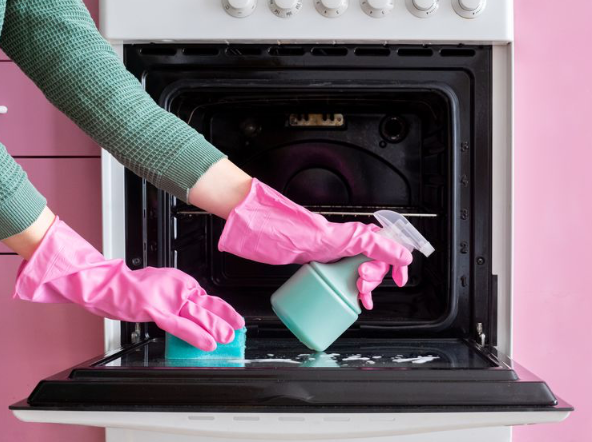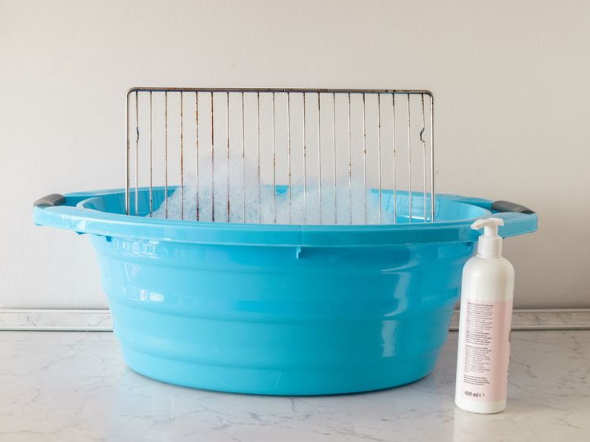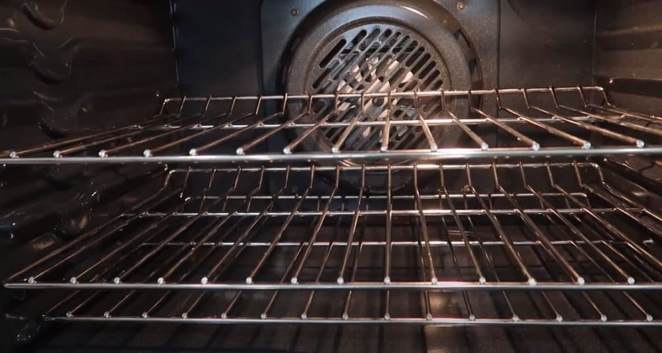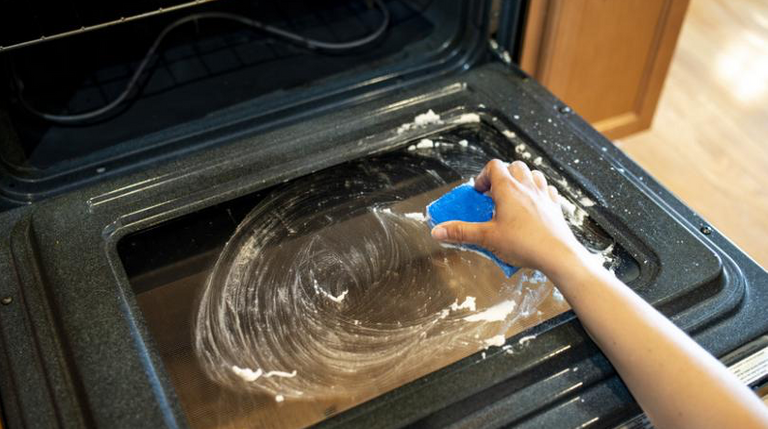How to Clean an Oven Thoroughly Plus, How Often You Should Clean It

Ovens are one of those kitchen appliances that have the distinct ability to turn into a culinary crime scene real fast. There are the steak drippings that have accumulated in a sludgy pool at the bottom, a rogue french fry that slipped through the rack and has essentially turned into pure carbon, and the slick film of grease on the glass that has prevented you from being able to peer into the oven for months.
Not sure how to clean an oven or where to even begin? It may seem overwhelming, but the reward of a sparkly clean oven—and the promise of better-tasting food—makes it worth the effort. Luckily, deep cleaning an oven isn't as scary as you might think. From the simple press of a button to concoctions that melt grease away, here's everything you need to know about how to clean an oven.
How Often Should You Clean Your Oven?
Use the self-cleaning function.
It almost sounds too good to be true, but many modern ovens come with a self-cleaning feature. "The self-clean cycle is a time-saving convenience feature," says Bristow. "During the cleaning cycle, the oven is heated to about 880 degrees Fahrenheit. At this temperature, food inside the oven incinerates, leaving behind a small amount of ash. The leftover ash wipes out easily with a damp cloth."
Bristow says that self-cleaning is, by far, the easiest way to clean an oven. It's also one of the best ways to clean an oven if you don't want to mess with chemical oven cleaners or even DIY cleaners. The primary drawback is that your oven locks up for three to five hours and lets off some serious heat, which isn't ideal in the warmer months. It can also produce an unpleasant odor, and you should keep pets and yourself out of the kitchen during the process.
You also want to keep in mind a few tips for self-cleaning ovens. "No commercial oven cleaner or oven liner should be used in or around any part of a self-clean oven as it will damage the enamel coating of the oven. Also, depending on your oven model, the pans and racks may need to be removed," says Bristow. "Finally, whether using the self-clean or steam-clean cycles, or even just cleaning the oven manually, always make sure that the unit has cooled to room temperature before attempting to wipe out the oven interior."
Bristow notes that you may need to self-clean your oven more than once to remove really baked-on grease and stains, and it may take some elbow grease to wipe out the residue.
Use a store-bought oven cleaner.
While the self-clean cycle does a pretty good job of removing baked-on grease and other grime from your oven, you've got a handful of alternatives. One option is to use a chemical store-bought cleaner. After removing any large pieces of loose food, spray your choice of cleaner evenly onto the interior of the oven and allow it to sit for at least 30 minutes. The cleaner lifts the grime and grease, allowing you to easily wipe it away.
Because the chemicals are potent, it's best to open windows and wear gloves and a face mask while cleaning the oven.
Use a DIY oven cleaner.
If you want to clean your oven without oven cleaner, you can DIY a natural cleaner using baking soda, vinegar, and water.
"We say skip the chemical oven cleaner and use a safe and simple solution that still gives you awesome results. A great homemade oven cleaner is a combination of baking soda and water. The baking soda acts as an abrasive and the water softens baked on crud and loosens food particles," says Jessica Samson, spokesperson for The Maids. "Make a paste and apply it liberally on the oven's interior surfaces and give it at least 20 minutes ideally longer to break down the burned food."
You can also add a bit of vinegar to your baking soda mixture for some extra cleaning power. Simply spray the vinegar on top and allow it to bubble and set for 20 minutes. Next, use a non abrasive pad to gently scrub all surfaces and follow up with a damp microfiber cloth.

Remove and soak the racks.
"Regardless of what type of oven you have, the best way to clean the metal racks is to remove them from the oven entirely and soak them in boiling water with a little dishwasher detergent," says Ron Shimek, president of Mr. Appliance. "The bathtub is a suitable place to soak oven racks, though you may want to clean the tub afterward. After soaking for two hours, scrub the racks with a stiff brush, rinse, and dry before returning them to the oven."

Add baking soda to remove stubborn spots.
Instead of boiling water, you can also use the baking soda and water mixture with vinegar spray. The key is letting it sit long enough for the ingredients to work their magic so that scrubbing is minimal.
Use the self-clean function for porcelain racks.
If you have porcelain racks instead of metal, Bristow says that you can leave them in your oven when using the self-clean cycle. He also notes that if you're lucky, your oven may even have a steam-clean option that quickly takes care of small food spills on your racks. This cycle requires a much lower heat than traditional self-cleaning.
"Steam clean does not involve chemicals, so standard pans and racks can remain in the oven during cleaning, and it should be used more often than self-clean to avoid stubborn stains from becoming baked on," says Bristow.
How to Clean Oven Knobs
Use a microfiber rag to wipe knobs down.
A simple damp microfiber rag used on and around the knobs will do the trick. If the job requires it, use a rag with a bit of soap or a disposable wipe.
Avoid spraying directly on the knobs.

The liquid could get behind the knobs and switches and short out the control panel," he says. "Instead, spray a rag with liquid cleaner and then rub the controls to prevent shorting."
How to Clean Glass Oven Doors
Mix baking soda into a paste and apply.

Your oven's glass door requires a gentler approach compared to the racks since glass is more susceptible to scratches. That means skipping abrasive products and using a less aggressive scrubbing technique.
"To clean your oven door glass without scratching it, mix baking soda and water for a thick paste. Spread the paste generously on the glass and let it sit for 20 or more minutes," says Samson. "After, gently wipe up the paste with a microfiber cloth, rinse thoroughly with water, and buff it dry for a sparkling shine."
Wipe down glass with glass cleaner.
Alternatively, you can spritz on soapy water or an oven cleaner. To finish the job, use a standard glass cleaner or a bit of diluted vinegar and a soft cloth for extra shine.
Remove dust and debris from hidden areas.
Sometimes an oven's glass door is comprised of two pieces of glass, which can lead to an accumulation of crumbs, dust, or grease streaks over time. This is something you can clean easily, though it does require a few extra steps.
First, open the door and rest it on your leg for support, then unscrew along the top of the door. By letting the door rest on your legs you'll prevent it from falling and breaking. Once unscrewed, you'll have access to the in-between layers of the oven. To clean up dust and crumbs, use a vacuum hose with a small nozzle. To clean grease, use a damp sponge with a long handle.
Thank you for taking the time to look at our profile and post we look forward to posting lots of content for you guys to view in the future from myself Simon and my partner Melissa hence the MS Logo design and company name .
WE CLEAN
PUBS
BARS
RESTRAUNTS
CLUBS
HOUSES
OFFICES
FLATS
HOTELS
B&B
SHOPS
GYMS
END OF TENANCY CLEAN
BUILD CLEAN
OVEN /APLIANCE CLEANS
CHAIR / SOFA CLEAN
RUG CLEAN
CARPETS
AND ANY KIND OF COMPANY THAT NEEDS A CLEANING SERVICES.
FEEL FREE TO CONTACT US VIA OUR EMAIL OR FOLLOW AND DM US ON OUR SOCIAL MEDIA SHOWN UNDER THIS SECTION.


YOU CAN FIND OUR SOCIAL MEDIA LINKS
FACEBOOK PAGE ⚜️
https://www.facebook.com/profile.php?id=100084926149710
INSTAGRAM ⚜️
https://www.instagram.com/msccleaningservices/
YOUTUBE CHANNEL
https://www.youtube.com/@mscleaning
TIKTOK
https://www.tiktok.com/@smccleney


